Piedmont, which means foot of the mountain, is almost completely encircled by the Alps. Winters are cold and snowy, summers are warm and dry, and in the fall during the harvest season, the weather is often cool and foggy. Besides its wines, the region is famous for its cuisine rich in flavors, featuring game, porcini and white truffles.
When we think about Piedmontese wines, we think of the intensely flavorful Barolos and Barbarescos, and maybe the fruity Barberas, but few of us have tried the region's excellent whites that made from ancient, indigenous, sometimes almost extinct grapes.
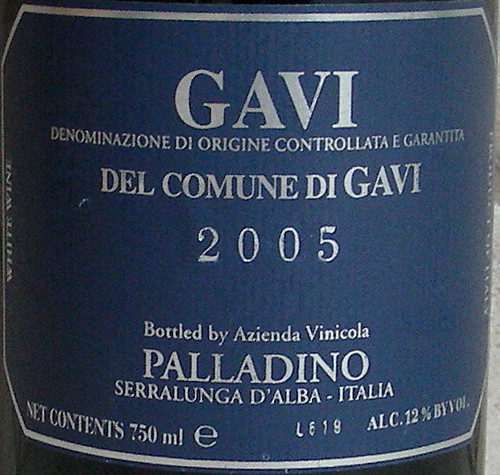 We tasted two whites from Piedmont. The first one was the 2005 Palladino Gavi di Gavi. Run by the Palladino family, the Azienda Vinicola Palladino is the oldest of the area. The Gavi di Gavi is one of the producer's most popular wines. Gavi is a wine made exclusively from the Cortese grape, an indigenous variety from the hills of southeastern Piedmont. The wine had a golden color with grapefruit and citrus aromas on the nose. On the palate, it had a crisp acidity and a fat mouthfeel. It was excellent served as an aperitif and should also work well with a fish dish in a light cream sauce.
We tasted two whites from Piedmont. The first one was the 2005 Palladino Gavi di Gavi. Run by the Palladino family, the Azienda Vinicola Palladino is the oldest of the area. The Gavi di Gavi is one of the producer's most popular wines. Gavi is a wine made exclusively from the Cortese grape, an indigenous variety from the hills of southeastern Piedmont. The wine had a golden color with grapefruit and citrus aromas on the nose. On the palate, it had a crisp acidity and a fat mouthfeel. It was excellent served as an aperitif and should also work well with a fish dish in a light cream sauce.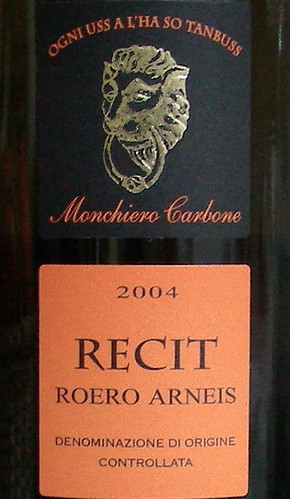 Our second white was the 2004 Monchiero Carbone Roero Arneis Recit. Because of its thin skin, Arneis, which means little rascal in the local dialect, is hard to cultivate and hard to vinify. By the 1960s, Arneis was nearly extinct and was often vinified and blended with Nebbiolo. But thanks to a few Barolo producers, the varietal was saved from extinction. The Roero Arneis Recit is unwooded and packaged in a dark bottle to prevent premature aging. It had a pleasant fragrant nose. The palate was full-bodied with a rich mouthfeel and a distinctive stony finish. It was absolutely delicious with the Vitello Tonnato dish that one of our friends had brought, a Piedmontese specialty with veal, tuna, capers, and anchovies.
Our second white was the 2004 Monchiero Carbone Roero Arneis Recit. Because of its thin skin, Arneis, which means little rascal in the local dialect, is hard to cultivate and hard to vinify. By the 1960s, Arneis was nearly extinct and was often vinified and blended with Nebbiolo. But thanks to a few Barolo producers, the varietal was saved from extinction. The Roero Arneis Recit is unwooded and packaged in a dark bottle to prevent premature aging. It had a pleasant fragrant nose. The palate was full-bodied with a rich mouthfeel and a distinctive stony finish. It was absolutely delicious with the Vitello Tonnato dish that one of our friends had brought, a Piedmontese specialty with veal, tuna, capers, and anchovies.Then we tasted the following reds:

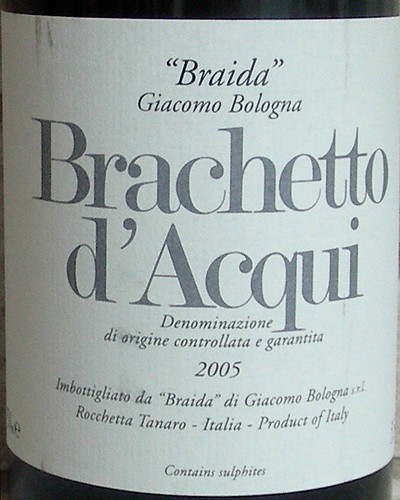 • 2005 Braida di Giacomo Bologna Brachetto d'Acqui: Braida means stretch ball and is a local Piedmontese sport. It was also the favorite pastime and the nickname of Giacomo Bologna's father. While Barbera d'Asti is the winery's main production, it also produces some amount of Brachetto d'Aqui, a low alcohol, sweet, red sparkling wine, named for the Brachetto grape as well as the Acqui district near the town of Asti. Showing a light red/pink color, the Braida Brachetto d'Acqui had a fruity nose of raspberry and blackberry. Slightly fizzy and semi-sweet on the palate, it was fresh and light with an alcohol content of only 5.5%. This Brachetto left nobody indifferent: some guests really loved it, others had hard time finishing their glasses: too sweet, too fizzy, too light.
• 2005 Braida di Giacomo Bologna Brachetto d'Acqui: Braida means stretch ball and is a local Piedmontese sport. It was also the favorite pastime and the nickname of Giacomo Bologna's father. While Barbera d'Asti is the winery's main production, it also produces some amount of Brachetto d'Aqui, a low alcohol, sweet, red sparkling wine, named for the Brachetto grape as well as the Acqui district near the town of Asti. Showing a light red/pink color, the Braida Brachetto d'Acqui had a fruity nose of raspberry and blackberry. Slightly fizzy and semi-sweet on the palate, it was fresh and light with an alcohol content of only 5.5%. This Brachetto left nobody indifferent: some guests really loved it, others had hard time finishing their glasses: too sweet, too fizzy, too light. • 2004 Ruggeri Corsini Dolcetto d'Alba: founded in 1843 by the Besserat family, Podere Ruggeri Corsini is a husband and wife operation located in Monforte d'Alba, one of the main communes in the Barolo Appellation. The wine is made from Dolcetto, which means the little sweet one, an easy to drink, medium-bodied, and fruity varietal. It had a bright reddish-purple color and a floral nose of violets. On the palate, it was round with mineral flavors and a fresh peppery finish.
• 2004 Ruggeri Corsini Dolcetto d'Alba: founded in 1843 by the Besserat family, Podere Ruggeri Corsini is a husband and wife operation located in Monforte d'Alba, one of the main communes in the Barolo Appellation. The wine is made from Dolcetto, which means the little sweet one, an easy to drink, medium-bodied, and fruity varietal. It had a bright reddish-purple color and a floral nose of violets. On the palate, it was round with mineral flavors and a fresh peppery finish. • 2004 Michele Chiarlo Barbera d'Asti Superiore Le Orme: Michele Chiarlo is a leading figure in the Italian wine industry. He is one of the first Italian producers to have introduced malolactic fermentation in Italy, in order to make more stable wines with not as much acidity and easier to drink young. The Barbera d'Asti, made from the Barbera grape, is one of his most popular wines. It had a deep red color, fruity aromas, a structured backbone and a well balanced palate with some good acidity. It was excellent to accompany a plate of prosciutto, salami, and cheese.
• 2004 Michele Chiarlo Barbera d'Asti Superiore Le Orme: Michele Chiarlo is a leading figure in the Italian wine industry. He is one of the first Italian producers to have introduced malolactic fermentation in Italy, in order to make more stable wines with not as much acidity and easier to drink young. The Barbera d'Asti, made from the Barbera grape, is one of his most popular wines. It had a deep red color, fruity aromas, a structured backbone and a well balanced palate with some good acidity. It was excellent to accompany a plate of prosciutto, salami, and cheese.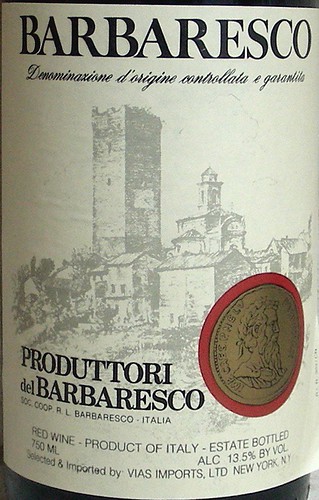 • 2002 Produttori del Barbaresco Barbaresco: Founded in the 1950s, the Produttori del Barbaresco is a cooperative that is known to produce high quality wines, and that has become a model for the other wine cooperatives in Italy. Barbaresco is a powerful wine made purely from Nebbiolo, a noble grape considered to be one of the world's greatest wine varieties. The wine had a red brick color and a powerful nose with complex aromas. The palate was rich, full-bodied, with firm tannins.
• 2002 Produttori del Barbaresco Barbaresco: Founded in the 1950s, the Produttori del Barbaresco is a cooperative that is known to produce high quality wines, and that has become a model for the other wine cooperatives in Italy. Barbaresco is a powerful wine made purely from Nebbiolo, a noble grape considered to be one of the world's greatest wine varieties. The wine had a red brick color and a powerful nose with complex aromas. The palate was rich, full-bodied, with firm tannins.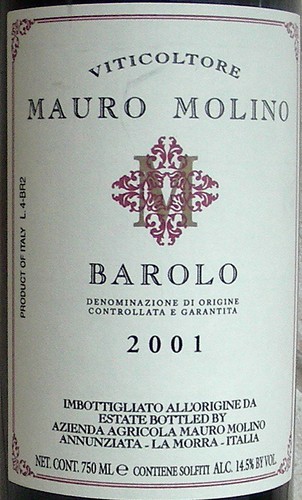 • 2001 Mauro Molino Barolo: Molino is very highly regarded producer from the village of La Morra in the Barolo Appellation. Its 8 hectare vineyard is mainly planted with Nebbiolo (60%) and also includes Barbera (20%), Dolcetto (10%), and Chardonnay (10%). Barolo, also made from Nebbiolo, is considered the most famous Piedmontese wines. This one had a ruby color and a light floral nose. The palate had intense and complex flavors and a long finish. This great wine should be paired with rich food such as beef braised in wine, wild mushroom risotto, and truffles.
• 2001 Mauro Molino Barolo: Molino is very highly regarded producer from the village of La Morra in the Barolo Appellation. Its 8 hectare vineyard is mainly planted with Nebbiolo (60%) and also includes Barbera (20%), Dolcetto (10%), and Chardonnay (10%). Barolo, also made from Nebbiolo, is considered the most famous Piedmontese wines. This one had a ruby color and a light floral nose. The palate had intense and complex flavors and a long finish. This great wine should be paired with rich food such as beef braised in wine, wild mushroom risotto, and truffles.
Our next tasting event will feature the wines of two other amazing wine regions: New Zealand and Australia, so don't miss it!
Previous wine club tastings:
• From Old World To New World
• Champagne Tasting

Technorati tags: wine food & drink
4 comments:
Hi Catherine,
I enjoyed this very much. Sounds like you have one heck of a tasting group. Does everyone bring food or does one rotating host do that? I have a tasting group too but I seem to be the only host, food preparer, etc. I need to branch out some more. Any advice?
By the way, I cannot believe that it has taken me so long to familiarize myself with your wonderful blog. Take care!
There are many ways to do it but in this case, people take turns hosting the tasting club and I take care of the wine and some appetizers/finger food to go with it.
I also have another tasting group where the host cooks and each guest brings a bottle of wine that we taste blind.
Glad you like my blog!
I am jealous - I want a tasting group like that. Or better yet, I want to be in your tasting group. If you get a minute, check out my blog - there are a few posts about our tasting group. We recently did Gruner Veltliner, and have done young Loire reds and others in the past.
Take care,
BKG
Hope you can taste and appreciate also our Nebbiolo in the next future! ;)
Post a Comment